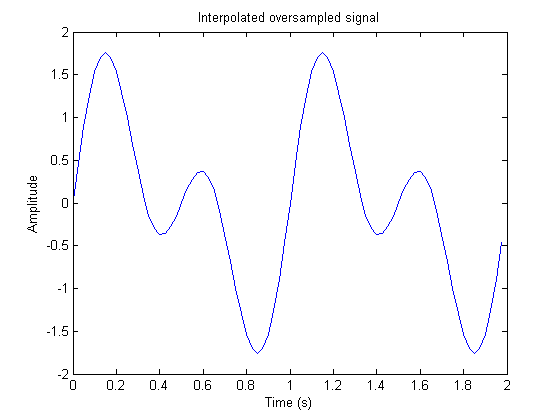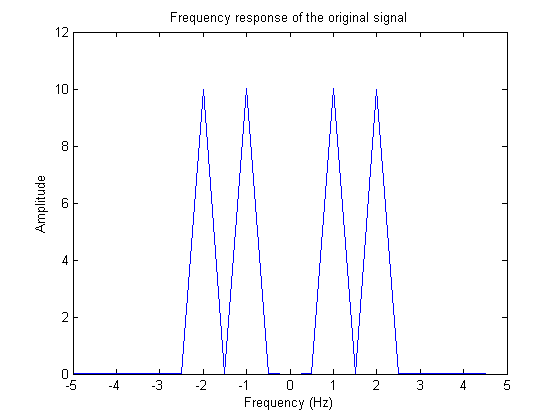Mark's Homework 15: Difference between revisions
Jump to navigation
Jump to search
No edit summary |
|||
| Line 3: | Line 3: | ||
==MATLAB Script== |
==MATLAB Script== |
||
The following is currently '''NON-WORKING'''. A working script will follow. |
|||
<pre> |
<pre> |
||
%Author: Mark Priddy |
|||
%Homework #15 MATLAB script |
|||
%Description: Demonstrates oversampling and cancelling of the effects of the D/A converter |
|||
clear all; |
clear all; |
||
close all; |
close all; |
||
N = 10; %Number of sample points for our original signal |
|||
%Number of sample points for our original signal |
|||
N = 20; |
|||
| ⚫ | |||
%Time, in seconds, to extend our original signal. We then sample this signal N times |
|||
T=tmax/N; %Calculate T, the sample period |
|||
tmax=2; |
|||
| ⚫ | |||
oversampling = 4; |
|||
%Calculations |
|||
T=tmax/N; |
|||
t=0:T:(N-1)*T; |
t=0:T:(N-1)*T; |
||
| ⚫ | |||
%This is our signal to over sample |
|||
| ⚫ | |||
%The following three lines is our oversampling/interpolating filter |
|||
N1=(oversampling-1)*N; |
N1=(oversampling-1)*N; |
||
X=fft(x); |
X=fft(x); |
||
X1 = (N1+N)/N*[X(1:N/2), zeros(1, N1), X(N/2+1:N)]; |
X1 = (N1+N)/N*[X(1:N/2), zeros(1, N1), X(N/2+1:N)]; |
||
%This preserves our interpolated signal for graphing later on |
|||
x2= ifft(X1); |
x2= ifft(X1); |
||
% |
|||
%This is to cancel out the effects of the D/A Converter |
%This is to cancel out the effects of the D/A Converter |
||
% |
|||
sT = T/100; %sT is hwo many times we are going to sample our pulse p(t) |
|||
%sT is how many times we are going to sample our pulse p(t) |
|||
sT = T*oversampling; |
|||
| ⚫ | |||
%This is how wide our pulse has to be when we oversample |
|||
stmax = oversampling*T; |
|||
| ⚫ | |||
sN = stmax/sT; |
|||
t = 0:sT:stmax-sT; |
t = 0:sT:stmax-sT; |
||
%This is p(t), the pulse of the D/A converter, sampled at our oversampling rate |
|||
p = u(t+1e-9) - u(t-T/(2*oversampling)) + u(t - (oversampling*T-T/(2*oversampling))); |
p = u(t+1e-9) - u(t-T/(2*oversampling)) + u(t - (oversampling*T-T/(2*oversampling))); |
||
%P(f) is calculated: |
|||
P = fft(p); |
P = fft(p); |
||
P(161) = 1e-19; |
|||
| ⚫ | |||
numpoints = 2*T/sT; |
|||
%We can only go out to 1/(2*T) on the 1/P(f). The rest we need to zero out. |
|||
iP = [iP(1:numpoints) zeros(1, sN-numpoints*2-1) iP(sN-numpoints:sN)] |
|||
iP = iP(1:sN/(N1+N):sN); %Down sample 1/P(f) so we can element multiply with our interpolating filter |
|||
| ⚫ | |||
%This plots P(f) |
|||
iP = 1./P; |
|||
f = -1/(2*sT):1/(sN*sT):1/(2*sT)-1/(sN*sT); |
|||
Ps = fftshift(P); %Shift P(f) |
|||
%Figure 4 plots P(f) shifted |
|||
figure(4) |
|||
plot(f, abs(Ps)); |
|||
%Figure 5 plots P(f) shifted and zoomed in the f axis |
|||
figure(5) |
|||
plot(f(sN/2-numpoints+1:sN/2+numpoints), abs(Ps(sN/2-numpoints+1:sN/2+numpoints))); |
|||
%Element multiply our interpolating filter with our D/A converter effect canceller filter |
|||
X1 = X1 .* iP; |
|||
x1 = ifft(X1); |
x1 = ifft(X1); |
||
% |
|||
| ⚫ | |||
%Graphs |
|||
%converter effects cancelled.) |
|||
% |
|||
| ⚫ | |||
figure(1) |
figure(1) |
||
t1 = 0:N/(N+N1)*T:(N-1/(N1+N))*T; |
t1 = 0:N/(N+N1)*T:(N-1/(N1+N))*T; |
||
plot(t1, x1, 'bo'); |
|||
hold on |
|||
t=0:T:(N-1)*T; |
t=0:T:(N-1)*T; |
||
plot( |
plot(t1, x1, 'bo', t, x, 'r-o', t1, x2, 'g-'); |
||
legend('Interpolated signal with D/A effects cancelled', 'Original sampled signal', 'Interpolated oversampled signal') |
|||
hold off |
|||
xlabel('Time (s)'); |
|||
ylabel('Amplitude'); |
|||
%Figure 2 plots just our interpolated signal, but this time with lines |
%Figure 2 plots just our interpolated signal, but this time with lines connecting each point. |
||
%connecting each point. |
|||
figure(2) |
figure(2) |
||
plot(t1, x1, 'b-'); |
plot(t1, x1, 'b-'); |
||
title('Interpolated oversampled signal'); |
|||
xlabel('Time (s)'); |
|||
ylabel('Amplitude'); |
|||
%Figure 3 plots the frequency response of our original sampled signal. |
%Figure 3 plots the frequency response of our original sampled signal. |
||
figure(3) |
figure(3) |
||
Xs((N+1)/2:N) = X(1:(N+1)/2); %The fftshift didn't work for me |
|||
Xs(1:(N+1)/2) = X((N+1)/2:N); %So this manually shifts the FFT |
|||
f = -1/(2*T):1/(N*T):1/(2*T)-1/(N*T); |
f = -1/(2*T):1/(N*T):1/(2*T)-1/(N*T); |
||
plot(f,abs( |
plot(f,abs(fftshift(X))) |
||
title('Frequency response of the origianl signal'); |
|||
%figure(4) |
|||
xlabel('Frequency (Hz)'); |
|||
%plot(f, abs(fftshift(X1))) |
|||
ylabel('Amplitude'); |
|||
</pre> |
|||
To run this script, you'll also need another script, called "u.m" with the following contained inside. This must be located in the same folder as the main script above. |
|||
<pre> |
|||
function [out] = u(t) |
|||
out=(1+sign(t))./2; |
|||
end |
|||
</pre> |
</pre> |
||
I couldn't find MATLAB's step function, so I created my own. |
|||
==Graphs== |
==Graphs== |
||
[[Image:OVR20071203Fig1.png|thumb|left|694px| Figure 1. The sampled signal with only 7 sample points.]] |
|||
[[Image:OVR20071203Fig2.png|thumb|left|694px| Figure 2. The DFT of Figure 1.]] |
|||
[[Image:OVR20071203Fig3.png|thumb|left|894px| Figure 3. The same as Figure 1 but with 600 sample points, and zoomed in.]] |
|||
<br clear="all"/> |
|||
==Explanations== |
==Explanations== |
||
Revision as of 17:59, 3 December 2007
Problem
Make a MATLAB script to do four times oversampling and a filter so as to eliminate as much as possible the effect of the D/A converter that follows the interpolation filter.
MATLAB Script
%Author: Mark Priddy
%Homework #15 MATLAB script
%Description: Demonstrates oversampling and cancelling of the effects of the D/A converter
clear all;
close all;
%Number of sample points for our original signal
N = 20;
%Time, in seconds, to extend our original signal. We then sample this signal N times
tmax=2;
%Number of oversampling points
oversampling = 4;
%Calculations
T=tmax/N;
t=0:T:(N-1)*T;
%This is our signal to over sample
x=sin(2*pi*t)+sin(2*pi*2*t)+sin(2*pi*5*t);
%The following three lines is our oversampling/interpolating filter
N1=(oversampling-1)*N;
X=fft(x);
X1 = (N1+N)/N*[X(1:N/2), zeros(1, N1), X(N/2+1:N)];
%This preserves our interpolated signal for graphing later on
x2= ifft(X1);
%
%This is to cancel out the effects of the D/A Converter
%
%sT is how many times we are going to sample our pulse p(t)
sT = T*oversampling;
%This is how wide our pulse has to be when we oversample
stmax = oversampling*T;
%This is the total number of sampling points for sampling p(t)
sN = stmax/sT;
t = 0:sT:stmax-sT;
%This is p(t), the pulse of the D/A converter, sampled at our oversampling rate
p = u(t+1e-9) - u(t-T/(2*oversampling)) + u(t - (oversampling*T-T/(2*oversampling)));
%P(f) is calculated:
P = fft(p);
%Take 1/P(f) so we cancel the effects of the D/A converter (which is P(f))
iP = 1./P;
%Element multiply our interpolating filter with our D/A converter effect canceller filter
X1 = X1 .* iP;
x1 = ifft(X1);
%
%Graphs
%
%Figure 1 plots the original signal and our interpolated signal (with D/A converter effects cancelled.)
figure(1)
t1 = 0:N/(N+N1)*T:(N-1/(N1+N))*T;
t=0:T:(N-1)*T;
plot(t1, x1, 'bo', t, x, 'r-o', t1, x2, 'g-');
legend('Interpolated signal with D/A effects cancelled', 'Original sampled signal', 'Interpolated oversampled signal')
xlabel('Time (s)');
ylabel('Amplitude');
%Figure 2 plots just our interpolated signal, but this time with lines connecting each point.
figure(2)
plot(t1, x1, 'b-');
title('Interpolated oversampled signal');
xlabel('Time (s)');
ylabel('Amplitude');
%Figure 3 plots the frequency response of our original sampled signal.
figure(3)
f = -1/(2*T):1/(N*T):1/(2*T)-1/(N*T);
plot(f,abs(fftshift(X)))
title('Frequency response of the origianl signal');
xlabel('Frequency (Hz)');
ylabel('Amplitude');
To run this script, you'll also need another script, called "u.m" with the following contained inside. This must be located in the same folder as the main script above.
function [out] = u(t) out=(1+sign(t))./2; end
I couldn't find MATLAB's step function, so I created my own.
Graphs


